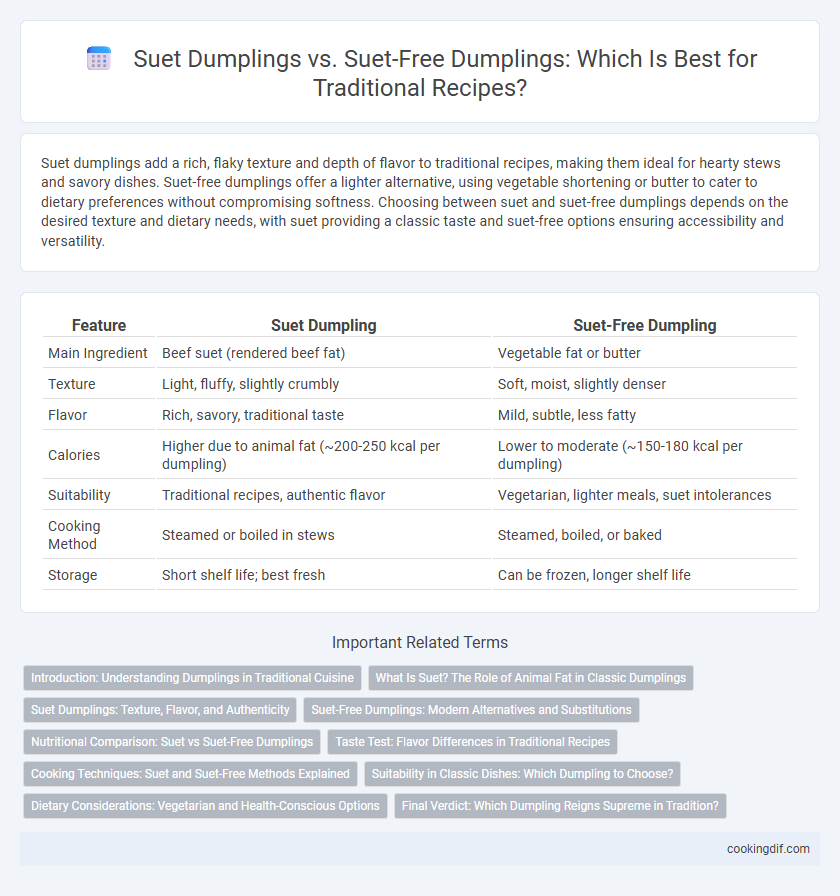Suet dumplings add a rich, flaky texture and depth of flavor to traditional recipes, making them ideal for hearty stews and savory dishes. Suet-free dumplings offer a lighter alternative, using vegetable shortening or butter to cater to dietary preferences without compromising softness. Choosing between suet and suet-free dumplings depends on the desired texture and dietary needs, with suet providing a classic taste and suet-free options ensuring accessibility and versatility.
Table of Comparison
| Feature | Suet Dumpling | Suet-Free Dumpling |
|---|---|---|
| Main Ingredient | Beef suet (rendered beef fat) | Vegetable fat or butter |
| Texture | Light, fluffy, slightly crumbly | Soft, moist, slightly denser |
| Flavor | Rich, savory, traditional taste | Mild, subtle, less fatty |
| Calories | Higher due to animal fat (~200-250 kcal per dumpling) | Lower to moderate (~150-180 kcal per dumpling) |
| Suitability | Traditional recipes, authentic flavor | Vegetarian, lighter meals, suet intolerances |
| Cooking Method | Steamed or boiled in stews | Steamed, boiled, or baked |
| Storage | Short shelf life; best fresh | Can be frozen, longer shelf life |
Introduction: Understanding Dumplings in Traditional Cuisine
Suet dumplings, made with rendered beef or mutton fat, provide a rich, dense texture that absorbs savory flavors in traditional recipes like stews and puddings. Suet-free dumplings use vegetable fats or oils as alternatives, catering to vegetarian or health-conscious diets while maintaining a lighter, fluffier consistency. Understanding the differences helps preserve authentic culinary methods and adapt them to modern dietary preferences.
What Is Suet? The Role of Animal Fat in Classic Dumplings
Suet is a type of hard animal fat derived primarily from beef or mutton, prized in traditional dumpling recipes for its ability to create a light, flaky texture and rich flavor. The presence of suet ensures moisture retention and a tender crumb, distinguishing classic suet dumplings from suet-free versions that often rely on vegetable fats or shortening. Suet-free dumplings provide a suitable alternative for vegetarians or those seeking lower saturated fat options, but may lack the characteristic mouthfeel and aroma produced by animal fat in traditional preparations.
Suet Dumplings: Texture, Flavor, and Authenticity
Suet dumplings offer a rich, moist texture that enhances traditional recipes with a distinctive, savory flavor derived from rendered beef or mutton fat. Their dense yet tender consistency absorbs stews and gravies efficiently, providing an authentic, hearty mouthfeel that suet-free alternatives often lack. The use of suet maintains the culinary heritage of classic British and Irish dishes, preserving the original taste and sensory experience cherished in traditional cooking.
Suet-Free Dumplings: Modern Alternatives and Substitutions
Suet-free dumplings offer a modern alternative for traditional recipes, catering to dietary restrictions and preferences such as vegetarian or low-fat diets. Ingredients like vegetable shortening, butter, or coconut oil effectively replicate suet's texture and moisture, ensuring tender and fluffy dumplings. This substitution enhances recipe versatility without compromising the authentic taste or consistency prized in classic dumpling dishes.
Nutritional Comparison: Suet vs Suet-Free Dumplings
Suet dumplings contain higher levels of saturated fat and calories due to the animal fat content, contributing to a richer flavor and denser texture in traditional recipes. Suet-free dumplings, often made with vegetable fats or alternatives, provide lower saturated fat and cholesterol, making them a healthier option for heart-conscious diets. Both types offer similar carbohydrate and protein content, but suet-free versions reduce the intake of animal-based fats while maintaining the classic dumpling consistency.
Taste Test: Flavor Differences in Traditional Recipes
Suet dumplings offer a rich, savory flavor with a dense, moist texture, enhancing traditional recipes by absorbing and intensifying surrounding broths and sauces. Suet-free dumplings tend to be lighter and fluffier, with a milder taste that allows the base flavors of the dish to stand out more prominently. Taste tests reveal that suet dumplings contribute a pronounced buttery depth, while suet-free options provide a subtler, cleaner palate experience.
Cooking Techniques: Suet and Suet-Free Methods Explained
Suet dumplings, made from raw beef or mutton fat, provide a rich, dense texture that holds up well in long simmering stews, offering a traditional hearty bite. Suet-free dumplings typically utilize vegetable fats or butter, resulting in a lighter, fluffier texture and quicker cooking times, ideal for those seeking a less heavy option. Mastering heat control and dough consistency is crucial in both methods to ensure the dumplings cook evenly and absorb surrounding flavors without disintegrating.
Suitability in Classic Dishes: Which Dumpling to Choose?
Suet dumplings offer a rich, dense texture ideal for hearty stews and traditional British dishes like steak and kidney pudding, enhancing flavor and authenticity. Suet-free dumplings provide a lighter, healthier alternative suitable for those with dietary restrictions or preferences, while still maintaining a tender consistency in soups and casseroles. Choosing between suet and suet-free depends on the desired texture and dietary needs, with suet dumplings best for classic recipes seeking robust taste.
Dietary Considerations: Vegetarian and Health-Conscious Options
Suet dumplings, rich in animal fat, provide a traditional, hearty flavor but are unsuitable for vegetarians and those seeking lower saturated fat intake. Suet-free dumplings, often made with plant-based fats or oils, cater to vegetarian and health-conscious diets by reducing calories and cholesterol while maintaining texture. Choosing suet-free options supports dietary preferences like vegetarianism and heart-healthy eating without compromising the classic dumpling experience.
Final Verdict: Which Dumpling Reigns Supreme in Tradition?
Suet dumplings boast a rich, authentic flavor and tender texture, making them a staple in traditional British recipes like steak and kidney pudding. Suet-free dumplings offer a lighter alternative suitable for vegetarian or health-conscious diets, but they often lack the characteristic depth and heaviness associated with classic dishes. In preserving culinary heritage, suet dumplings reign supreme by delivering the true essence of traditional cooking.
Suet Dumpling vs Suet-Free Dumpling for traditional recipes Infographic

 cookingdif.com
cookingdif.com